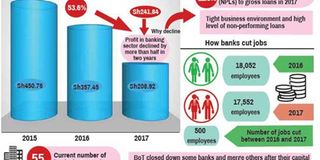Tanzanian banks lose Sh242 billion as business gets tough

Dar es Salaam. The glass is almost half empty for Tanzanian banks which have seen their profitability level declining by 53.65 per cent in the last two years amid tight business for the lenders.
The banking industry which is still growing in terms of assets registered the highest level of profits at Sh450.758 billion in 2015 but the net income slowed to Sh357.416 billion in 2016 and Sh208.921 billion in 2017, according to figures from the Bank of Tanzania.
That is a decline of Sh241.837 billion in profitability in the last two years in which the banks are challenged by high level of nonperforming loans (NPLs) which reached about 12 per cent last year and tight liquidity that limited the lenders in extending credit to economic activities.
Although the Bank of Tanzania says the banking industry is now stable for growth, some experts say it’s not that much worrying while others predict the slow profitability may take up to two more years to turn around to where it had reached in 2015.
Prof Delphin Rwegasira of the University of Dar es Salaam’ economics department says the drop of profitability and other challenges facing banks are the outcome of adjustments of the economy in what he termed a transition period.
“To me, the current situation is OK because of the fact that the banking sector is profitable and this profitability is better compared to other sectors of the economy. That is positive for me,” says Prof Rwegasira.
According to him, since Tanzania ‘seconomy is still growing, the banks will rebound “sooner than later.”
“Concerning when the banks will turn around, I cannot tell and I wouldn’t care about that as long as the banking sector is still profitable,” he added.
Prof Rwegasira says the future of banks remains bright following the recent regulatory moves which included closing down of some questionable lenders.
He was referring to the move taken in January this year when the central bank revoked the licences of five “critically undercapitalised.” community banks to protect financial stability.
For some bankers, the fall of profits is a wake-up call for the local banks to find alternative sources of revenue especially by refocusing on lending business. “For a long time, banks have been relying on subscribing to government securities – both Treasury bills and Treasury bonds – which is a risk-free investment.
When the government reduced the interest rates, even the revenue of the banks started declining. Of course investing in government securities is an easy investment but a lazy approach for banks,” says Mr Peter Nalitolela, the director of treasury and markets at the National Bank of Commerce.
“Banks should now change their approach to turn around the profitability levels….it may take up to two more years to revert to where the banking sector had reached in 2015,” he adds.
Governor of the Bank of Tanzania Prof Florens Luoga said this week that the lenders are now upping their loan issuance to the private sector as opposed to depending much on government securities.
Speaking at a working meeting between President John Magufuli and officials from Tanzania Revenue Authority (TRA) and Regional Commissioners, Prof Luoga said the growth of credit to private sector increased from 0.8 per cent in 2017 to 4.8 per cent in September 2018.
“Our roles as a regulator include ensuring growth of the banking sector….right now we do not have a liquidity problem in the market,” said Prof Luoga.
Last week, the International Monetary Fund (IMF) said nearly half of Tanzania’s banks are vulnerable to adverse shocks and risk insolvency in the event of a global financial crisis.
Solvency stress tests revealed that 22 banks, representing 32 per cent of banking assets, would become undercapitalised in the tail risk scenario, said the IMF in its latest financial system stability assessment of Tanzania.
Jobs declining
According to the central bank, the number of employees in the banking sector decreased by 2.77 per cent to 17,552 at the end of 2017 compared to 18,052 employees reported in 2016.
The Bank of Tanzania attributes the decrease to revocation of the licences of two banks and changes in banks’ business model leveraging on electronic channels.
Agent banking is one of the booming tools in Tanzania banking landscape with the number of agents almost doubling from 5,676 in December 2016 to 10,070 agents at the end of 2017.
Apart from branches and agent banking delivery models, the banking sector has also increased use of internet and mobile banking services.
These delivery channels have enabled the integration of banking services with mobile phone financial service providers.
According to the BoT, the value of mobile (SMS) banking transactions increased by 26.78 per cent to Sh2.76 trillion compared to Sh2.18 trillion recorded in the previous year.
The value of internet banking transactions also increased by 11.65 per cent to Sh50.765 trillion from Sh45.47 trillion reported in 2016.
The number of banks and financial institutions providing mobile banking services (SMS) was 33 while number of banking institutions offering internet banking was 22.
The evolution of digital banking channels raises the question whether the sector will be in a position to add direct jobs in the future amid falling of the profitability.




